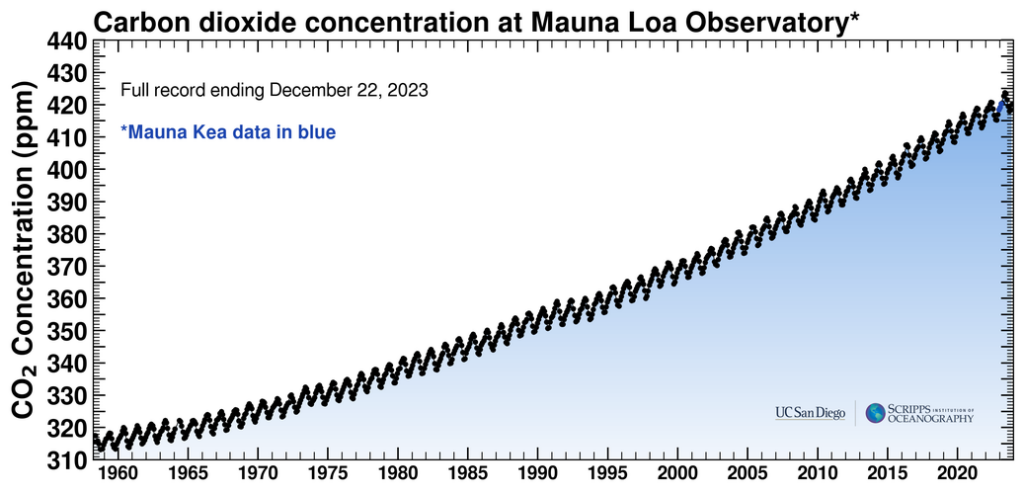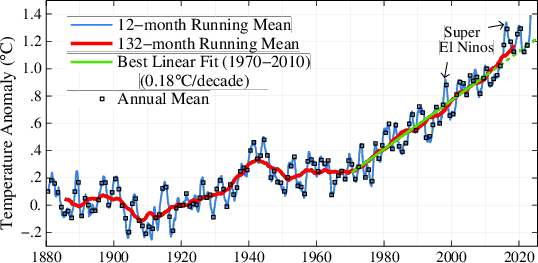The Story of Climate Change
Starting with the Keeling Curve
Climate change has become one of the most prominent and urgently addressed global issues of the 21st century. However, this critical concern did not emerge suddenly but has undergone a long history of evolution. This article will begin with the discovery of the Keeling Curve, tracing the timeline of human awareness of climate change. It will gradually reveal how scientists have step by step unveiled the changes in the Earth’s environment, ushering us into a new era of addressing climate change.
The Emergence of the Keeling Curve
As early as 1938, scientists, using historical secondary data, were studying the concentration of CO2 in the atmosphere and found that it was gradually increasing. However, due to the less rigorous research methods at that time, these findings were not widely accepted by the scientific community.
It wasn’t until Charles David Keeling, a researcher at the Scripps Institution of Oceanography, University of California, San Diego, dedicated himself to the study of climate change, that our understanding took a significant leap. In March 1958, he initiated a unique experiment at the Mauna Loa Observatory in Hawaii, intensively observing the atmospheric CO2. In 1960, he published a paper highlighting the synchronous increase in CO2 concentration and fossil fuel emissions.
In 2002, Keeling was honored with the National Medal of Science in the United States, and his proposed “Keeling Curve” became an iconic representation of climate change in the 20th century.

The Impact of the Industrial Revolution
The emergence of the Keeling Curve drew scientists’ attention to a crucial fact: since the Industrial Revolution, the concentration of carbon dioxide in the Earth’s atmosphere has sharply increased. This change is linked to the burning of fossil fuels, deforestation, and other human activities.
Scientists began to delve into the potential impacts of these phenomena, realizing that such climate change could have profound effects on the Earth’s ecosystems, extreme weather events, and sea-level rise. During this period, human understanding of climate change issues expanded rapidly, and the scientific community intensified its research efforts to unravel this complex puzzle.


Source:https://www.co2.earth/
CO2 concentration rises annually
The graph above depicts the Keeling Curve, which has been measuring CO2 concentration since 1958. It reveals a steady increase in Earth’s atmospheric CO2 concentration, closely tied to industrial activities involving the consumption of fossil fuels. From 313 ppm in 1958, it has surged by 34.2% as of November 2023, reaching 420 ppm.
The global average temperature has risen by 1.49°C.
Advancements in Earth Science
Entering the latter half of the 20th century, technological advancements in Earth science enabled scientists to delve deeper into the study of climate change. The use of meteorological satellites, the establishment of a global meteorological observation network, and the increased computational capabilities of supercomputers have provided crucial information for a more comprehensive understanding of the Earth’s system.
The application of these technologies has allowed scientists to simulate and predict trends in climate change, revealing challenges that different regions may face. Simultaneously, they have begun researching viable solutions to address climate change, including energy transition, forest conservation, and adjustments to social structures.
International Cooperation and Agreements
With in-depth research on the impact of climate change, the international community has gradually realized that it is a global issue that requires collective efforts to address. Countries have actively participated in international climate agreements, such as the 1992 Earth Summit in Rio and the 2015 Paris Agreement, to establish common emission reduction goals and climate action plans.
These agreements represent important milestones in the collective response of the international community to the challenges of climate change, highlighting the indispensable nature of global cooperation in addressing this critical issue. They provide a shared framework for countries to collectively pursue sustainable development and mitigate the impacts of climate change.
